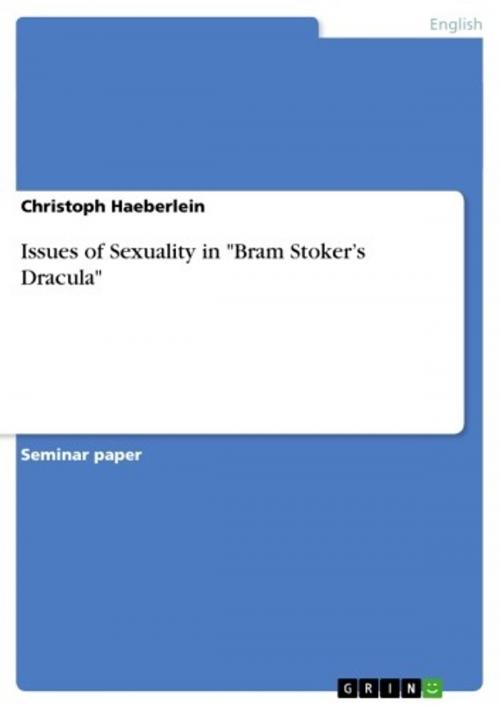Issues of Sexuality in 'Bram Stoker's Dracula'
Fiction & Literature, Literary Theory & Criticism, British| Author: | Christoph Haeberlein | ISBN: | 9783640135745 |
| Publisher: | GRIN Publishing | Publication: | August 12, 2008 |
| Imprint: | GRIN Publishing | Language: | English |
| Author: | Christoph Haeberlein |
| ISBN: | 9783640135745 |
| Publisher: | GRIN Publishing |
| Publication: | August 12, 2008 |
| Imprint: | GRIN Publishing |
| Language: | English |
Seminar paper from the year 2006 in the subject English Language and Literature Studies - Literature, grade: 1.7, University of Cologne, course: Gothic and Neo-Gothic Ficiton, 22 entries in the bibliography, language: English, abstract: Taking a look (an not even a close one) at movies or TV-series dealing with vampires, one immediately recognizes the vampire as a sexed-up figure, conveying the notion of the lascivious vamp as in Underworld, the noble alpha-male as in Blood Ties or the longed-for guardian and lover as in Moonlight. In her novels, Anne Rice describes the vampire's bite as a liturgical act (cf. Brittnacher 1994:131), Sheridan Le Fanu's female vampire Carmilla is actually a lesbian (cf. Leatherdale 1985, 54) and John Polidori's early story The Vampyre is considered to have successfully combined the vampire-motif with a seducing romanticism (Hurst 2002, 139; Leatherdale 1985, 51). There is a long tradition in sexing up vampire-figures, reaching back even to Bram Stocker's Dracula. Indeed, Bram Stoker combined different aspects of the literary vampire when he created Count Dracula (cf. Brittnacher 1994, 119ff; Hurst 141f). This mixture of well-tried elements may be one of the reasons why Bram Stoker's novel is widely seen as the 'by far best-known literary treatment of the vampire myth' (Bentley 1972, 27). Amazingly, Dracula has never been out of print since it was first published in 1897 (Leatherdale 1985, 11; McNally et.al. 1994, 133) and can thus be said to have become the figurehead for the vampirism-phenomena. Consequently, James Twitchell asserts that 'vampire and Dracula have become synonymous' (1981, 132).
Seminar paper from the year 2006 in the subject English Language and Literature Studies - Literature, grade: 1.7, University of Cologne, course: Gothic and Neo-Gothic Ficiton, 22 entries in the bibliography, language: English, abstract: Taking a look (an not even a close one) at movies or TV-series dealing with vampires, one immediately recognizes the vampire as a sexed-up figure, conveying the notion of the lascivious vamp as in Underworld, the noble alpha-male as in Blood Ties or the longed-for guardian and lover as in Moonlight. In her novels, Anne Rice describes the vampire's bite as a liturgical act (cf. Brittnacher 1994:131), Sheridan Le Fanu's female vampire Carmilla is actually a lesbian (cf. Leatherdale 1985, 54) and John Polidori's early story The Vampyre is considered to have successfully combined the vampire-motif with a seducing romanticism (Hurst 2002, 139; Leatherdale 1985, 51). There is a long tradition in sexing up vampire-figures, reaching back even to Bram Stocker's Dracula. Indeed, Bram Stoker combined different aspects of the literary vampire when he created Count Dracula (cf. Brittnacher 1994, 119ff; Hurst 141f). This mixture of well-tried elements may be one of the reasons why Bram Stoker's novel is widely seen as the 'by far best-known literary treatment of the vampire myth' (Bentley 1972, 27). Amazingly, Dracula has never been out of print since it was first published in 1897 (Leatherdale 1985, 11; McNally et.al. 1994, 133) and can thus be said to have become the figurehead for the vampirism-phenomena. Consequently, James Twitchell asserts that 'vampire and Dracula have become synonymous' (1981, 132).















